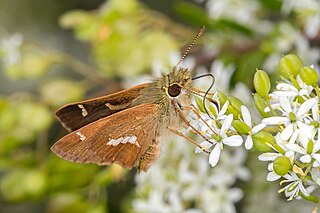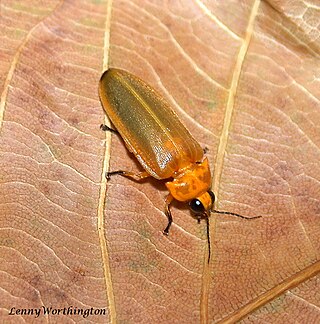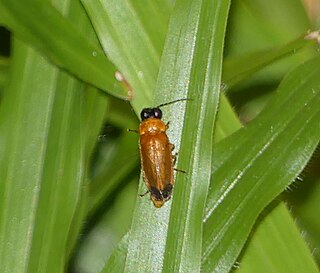
Actias selene, the Indian moon moth or Indian luna moth, is a species of saturniid moth from Asia. It was first described by Jacob Hübner in 1807. This species is popular among amateur entomologists and is often reared from eggs or cocoons that are available from commercial sources. They fly mainly at night.

Luciola is a genus of flashing fireflies in the family Lampyridae. They are especially well known from Japan and are often called Japanese fireflies, but their members range farther into Asia and reach southern Europe and Africa. This genus is traditionally held to extend to Australia, but these species do not seem to belong herein.

Dispar compacta, commonly known as the dispar skipper, barred skipper, or barred grass-skipper, is a species of butterfly in the family Hesperiidae. It was described by Arthur Gardiner Butler in 1882 as Telesto compacta and is endemic to eastern Australia.
Atyphella is a genus of 'flashing' firefly found in the Australasian region, particularly in the eastern and northern regions of Australia. The genus consists of 23 recognized species, 14 considered to be endemic to Australia.
Inflata is a genus of 'flashing' firefly found in Thailand, containing a single recognized species, Inflata indica.

Nipponoluciola cruciata, known as "genji-botaru" (ゲンジボタル) in Japanese, is a species of firefly found in Japan. Its habitat is small ditches and streams, and its larvae are aquatic. It was formerly known as Luciola cruciata but was revised taxonomically in 2022.
Aquatica ficta is a species of firefly found in Taiwan and parts of China. It was formerly placed in the genus Luciola. Its habitat is still water, and the larvae are aquatic.
Aquatica is a genus of fireflies in the subfamily Luciolinae. The species are found in China, Taiwan, Japan, Russia and Korea. Fu, Ballantyne and Lambkin erected the genus in 2010, using phylogenetic, morphological and behavioural evidence. Its type species is Aquatica wuhana. It contains five species:
Aquatica hydrophila is a species of firefly found in Taiwan. Described in 2003, it was formerly placed in the genus Luciola. The larvae are aquatic and live in ditches and small streams.

Aquatica lateralis, known as "heike-botaru" (ヘイケボタル) in Japanese, is a species of firefly found in Russia, Japan and Korea. It was formerly placed in the genus Luciola. The larvae are aquatic and live in rice paddies.
Luciola substriata is a species of firefly found in India, Myanmar, China and Taiwan. The larvae are aquatic and can swim, living in marshes, paddies, lakes and ponds.
Abscondita chinensis, is a species of firefly beetle found in India, China and Sri Lanka.
Abscondita promelaena is a species of firefly beetle found in India and Sri Lanka.

Asymmetricata humeralis is a species of firefly found in India and Sri Lanka.
Luciola candezei, is a species of firefly beetle found in Sri Lanka.
Luciola intricata, is a species of firefly beetle found in Sri Lanka.

Pteroptyx is a genus of fireflies in the subfamily Luciolinae found in Southeast Asia. It has long been noted for the ability to perform synchronous flashing, though not all species synchronize. These synchronizing species have been found on so-called 'firefly trees' and created a growing firefly-watching tour industry in some regions. Species of the genus have been identified in Malaysia, Thailand, the Philippines, and Hong Kong.

Abscondita is a genus of fireflies in tropical Asia. Species in the genus were earlier placed in the genus Luciola but molecular phylogeny studies support their separation.

Asymmetricata is a genus of fireflies found in tropical Asia. Species in the genus were formerly included in the genus Luciola. The genus was created in 2009 by Lesley Ballantyne who noted the asymmetric 8th abdominal tergite, emarginated on its left, as a shared feature. Adults of both males and females are winged. The larvae have been reliably described only in A. circumdata. They are terrestrial carnivores, feeding on snails and earthworms in moist soil below tree cover. The last abdominal segment bears an anchoring structure or pygopod with 58 or more pygopodia arising from it.

Sclerotia is a genus of fireflies in the subfamily Luciolinae. It contains seven species that occur in Southeast Asia. The larvae of at least three of these species are aquatic and swim on their backs.











